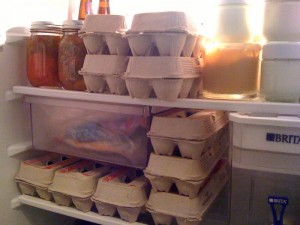 Preserving eggs in the refrigerator for 9 months is unfathomable to most people, let alone safely preserving eggs that long without refrigeration. But today I’ll make crystal clear how you can preserve eggs worry-free without compromising your health and taste standards and perhaps I’ll even shed some light on how you came to believe that eggs can only be preserved in a refrigerator.
Preserving eggs in the refrigerator for 9 months is unfathomable to most people, let alone safely preserving eggs that long without refrigeration. But today I’ll make crystal clear how you can preserve eggs worry-free without compromising your health and taste standards and perhaps I’ll even shed some light on how you came to believe that eggs can only be preserved in a refrigerator.I assure you that Kellene Bishop has not lost her mind; I’m not some maniacal bad guy accompanied by the theme music from Jaws as I write this. Just read further and you’ll understand that this Preparedness Pro is no fraud but some other trusted entities may have been feeding you a fish story for the past several decades.
Bottom line, if you look at how nature preserves eggs you can learn an awful lot about preserving your own regardless of whether your purchased them at your local superstore or you collected them yourself from your personal brood of hens.
 When a chicken lays an egg, it has a natural coating on it known as the bloom. This bloom is a layer of protection for the egg which keeps out oxygen as well as harmful bacteria and germs. It’s very, very common for those who raise chickens for their eggs to collect them and then keep them on the counter until they are ready to use—not put them in the refrigerator. And in fact, the majority of the grocery stores in the world don’t put their eggs in a refrigerated environment. When they’re ready to use the eggs, they either wash them, which eliminates the bloom and any bacteria or germs, or they crack them open—just as is—but take care not to do so over food that they are going to eat. Instead, they crack them into a separate dish or into a clean hand, but never over the food that they are mixing them. Also, in order to not spread the outside germs into the eggs, they never separate them with the egg shells; instead, they use their hands to separate the yolks from the whites.
When a chicken lays an egg, it has a natural coating on it known as the bloom. This bloom is a layer of protection for the egg which keeps out oxygen as well as harmful bacteria and germs. It’s very, very common for those who raise chickens for their eggs to collect them and then keep them on the counter until they are ready to use—not put them in the refrigerator. And in fact, the majority of the grocery stores in the world don’t put their eggs in a refrigerated environment. When they’re ready to use the eggs, they either wash them, which eliminates the bloom and any bacteria or germs, or they crack them open—just as is—but take care not to do so over food that they are going to eat. Instead, they crack them into a separate dish or into a clean hand, but never over the food that they are mixing them. Also, in order to not spread the outside germs into the eggs, they never separate them with the egg shells; instead, they use their hands to separate the yolks from the whites.While it’s absolutely normal for you and I to get our eggs from the refrigerated department of the grocery stores, it’s actually very unusual in the rest of the world; eggs, butter, and most cheese products are usually just sitting on the shelf, not in a refrigerated display. Mind you, that doesn’t mean that the U.S. is wrong in such practice, but it’s important to remember that the majority of steps taken by the food industry are to avoid a lawsuit or to comply with whatever figments of grandeur the USDA wields as it creates various requirements. Such policies are not necessary to practice in your own home. Keeping that in mind, there are several steps you can take so that you can take advantage of great sales on eggs and not have to worry about whether or not they will all fit in the refrigerator.
Preserving Eggs is Easy!
Yes, you can preserve your eggs long-term without worrying about your family getting sick. There are several methods you can use and I’ve written of a couple of ways previously, but my favorite one (because it’s the easiest) is using mineral oil.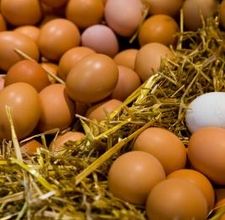 All you have to do is warm a quarter cup of mineral oil (just about 10 seconds in the microwave will do). Set your eggs outside of the carton (because it will be hard to get them out one you start using the mineral oil). Put on some food handling gloves (I buy this at one of the warehouses). They are easy to use for safe food handling but they are also a lot less expensive than medical gloves and yet in some circumstances they can be used instead of medical gloves. They are NOT puncture resistant though, so exercise caution if using them for that purpose). Dab a little bit of the warmed mineral oil on your hands and then pick up an egg. Run your oiled hands all over the eggs, making sure to cover it completely with the mineral oil. Don’t worry if you’re putting it on too thick or thin, just so long as every part of it is covered. When you’re finished with an egg, put it in the egg carton, small pointed side down. A quarter cup of mineral oil should easily do 4 to 6 dozen eggs.
All you have to do is warm a quarter cup of mineral oil (just about 10 seconds in the microwave will do). Set your eggs outside of the carton (because it will be hard to get them out one you start using the mineral oil). Put on some food handling gloves (I buy this at one of the warehouses). They are easy to use for safe food handling but they are also a lot less expensive than medical gloves and yet in some circumstances they can be used instead of medical gloves. They are NOT puncture resistant though, so exercise caution if using them for that purpose). Dab a little bit of the warmed mineral oil on your hands and then pick up an egg. Run your oiled hands all over the eggs, making sure to cover it completely with the mineral oil. Don’t worry if you’re putting it on too thick or thin, just so long as every part of it is covered. When you’re finished with an egg, put it in the egg carton, small pointed side down. A quarter cup of mineral oil should easily do 4 to 6 dozen eggs.Now, store your egg cartons in a cool, dry place. You want the temperature to be about 68 degrees for long-term storage—otherwise storing them like this in your regular room temperature is just fine for a few weeks. Remember, the eggs come out of a warm hen. I’m always asked if this will help the eggs keep longer in the refrigerator too. The answer is yes.
You’ll want to set a reminder on your calendar or cell phone to flip your eggs once a month at which time you’ll simply flip the carton upside down gently so as not to break any of the eggs. Do this every month to maintain the integrity of the egg yolk.
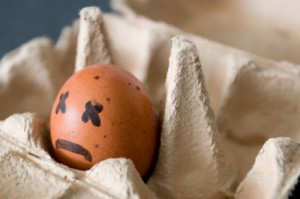 Don’t worry about an egg going bad and you not knowing it. Believe me; in this case the NOSE KNOWS. Rotten eggs smell awful. They won’t be able to sneak up on you. The gas hydrogen sulfide develops as bacteria breaks down the proteins in the egg white, creating that nasty gas smell.
Don’t worry about an egg going bad and you not knowing it. Believe me; in this case the NOSE KNOWS. Rotten eggs smell awful. They won’t be able to sneak up on you. The gas hydrogen sulfide develops as bacteria breaks down the proteins in the egg white, creating that nasty gas smell.There’s another way to tell if your egg has gone bad. As oxygen gets into the egg, it creates an air bubble inside in place of moisture and carbon dioxide. This will cause the egg to float when placed in cold water (at least double the depth as the length of the egg). Anything other than a floating egg is fine to ingest.
Don’t be put off by the other things that you might see in your egg. Some things may look odd to you, but don’t worry, there is nothing wrong with your egg when you see the little red spots in the yolk. Those spots (usually referred to as meat spots) just mean that a blood vessel ruptured during the formation of the egg. They are diluted as the egg gets older, which means that if you actually see them, your eggs are still quite fresh. Another misinterpreted egg issue is when you see a white strand (chalazae) in the egg white, usually right next to the yolk. It reminds me of a white umbilical cord. They are only there to keep the egg yolk centered and are sometimes more obvious in some eggs than others. Even if you see an egg white that is cloudy or has a yellow or green hue to it, it doesn’t mean that it’s bad. In fact, quite the opposite because it indicates that the carbon dioxide just hasn’t had enough time to escape the egg. Even if you end up with a fertilized egg, it’s still safe to eat.
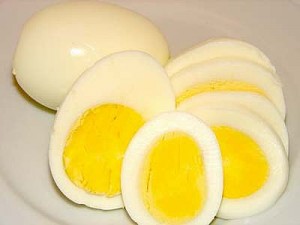 Of course all of these instructions for egg preservation only apply to eggs which you intend to cook prior to consuming. The nice thing about preserving eggs this way is that your deviled eggs will turn out better. The shells peel off of old hard-boiled eggs easier than fresh ones. In fact, the only downside I have found to preserving eggs this way is that they are pretty much useless when you want to whip up some egg whites. Old egg whites are very difficult to whip into a stiff stage once they’re older than a couple of weeks.
Of course all of these instructions for egg preservation only apply to eggs which you intend to cook prior to consuming. The nice thing about preserving eggs this way is that your deviled eggs will turn out better. The shells peel off of old hard-boiled eggs easier than fresh ones. In fact, the only downside I have found to preserving eggs this way is that they are pretty much useless when you want to whip up some egg whites. Old egg whites are very difficult to whip into a stiff stage once they’re older than a couple of weeks.Yes, you can do this method on grocery store eggs. The grocery store egg distributors make sure to wash off the bloom and then refrigerate them. Your mineral oil essentially reapplies the bloom. Of course I always look at the dates on the egg cartons and get them as “new” as possible. This preserving eggs method will allow your eggs to stay good for 9 months and sometimes as much as 12. Obviously, rotating through your eggs is standard, so I like to number or alphabetize my eggs so that I can keep the egg cartons together in the batches that I purchased them. That way if there ever is a problem with a group of eggs, I know where they came from and can look at all of the eggs that I bought in that particular batch. You could also simply use a color marker coding system and get the same result so long as you stick with a particular color cycle.
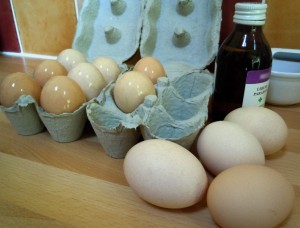 Mineral oil is the key to preserving eggs
Mineral oil is the key to preserving eggs
One last thing to mention here; the mineral oil. Mineral oil is found in the pharmaceutical sections along with Pepto Bismal, laxatives, etc. as it’s commonly used to help with bowels issues. However, I only use it for this purpose and with gloves on because it is a petroleum product. Petroleum products do cause estrogen dominance in a woman’s body which then causes a host of other problems in the body. So please don’t use it topically. This also goes for baby oil which is nearly 100% mineral oil except for the addition of a fragrance; though this means that you could also use baby oil in lieu of mineral oil.Now that you know that preserving eggs is easy, you can use your egg substitutes to bake with and you’ll still have plenty of great eggs for those times when you just gotta have an egg over easy, deviled eggs, poached eggs on toast, homemade mayonnaise or a delectable hollandaise sauce! A good hollandaise sauce makes the little bit of time I have to spend preserving eggs all worth it!
No comments:
Post a Comment